Ready to start your free design?
Take the first step toward your dream kitchen today! We’ll connect you with your personal designer to make your project a reality.
Start Your Free Kitchen Design
Cabinet knobs and pulls are like jewelry for the kitchen. The right kitchen cabinet hardware can complement and accentuate the lines, colors, and textures of your space. The placement and positioning of cabinet hardware also makes a kitchen more functional, but is there a correct placement for cabinet handles?
While hardware placement does affect the functionality of the space, it is a matter of personal taste. Looking at different arrangements of kitchen cabinet knobs and pulls will help you decide which styles and placements are right for you.
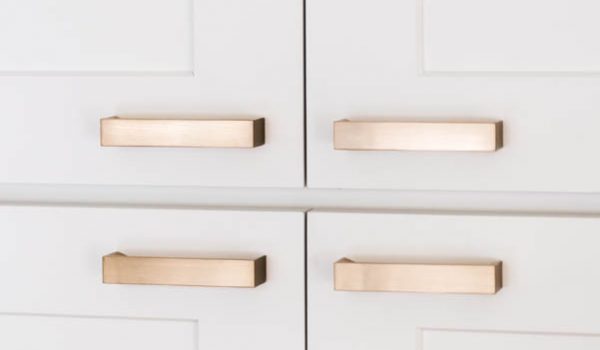
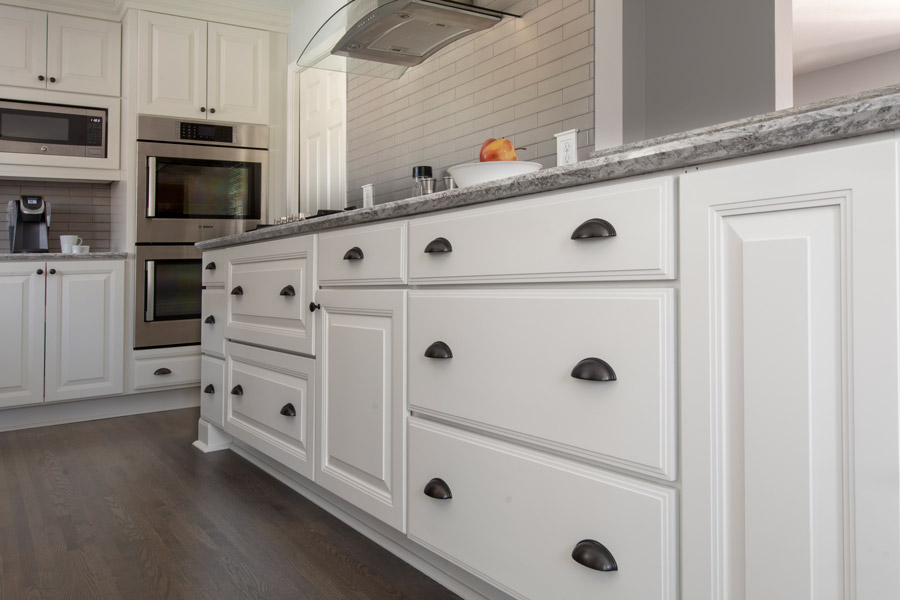
Take the first step toward your dream kitchen today! We’ll connect you with your personal designer to make your project a reality.
Start Your Free Kitchen DesignA kitchen cabinet knob is your most basic handle, suitable for doors and drawers alike. Knobs use a single screw and are traditionally round or circular. However, you can find them in shapes ranging from square to T-shape. When it comes to materials and finishes, there are choices ranging from wood to ceramic and crystal.
Cabinet knobs are placed opposite of door hinges. On wall cabinets, knobs are usually placed 2-1/2” to 3” from the bottom corner of the door. On base cabinets, they are placed 2-1/2” to 3” from the upper corner of the door.
On drawers and pull-out cabinets, drawer pulls and knobs are typically centered on the drawer front. If you prefer, you can set your knobs on the upper part of the drawer front, as shown above. A knob in this position can provide additional leverage when opening a sink tilt-out tray. When installing knobs for pull-out cabinets such as a waste basket, make sure you choose a size that can accommodate and disperse the weight of the pull-out accessory.
If your drawer is 24” or wider, consider adding a second knob. Divide the drawer into thirds and place one knob at each outer section.


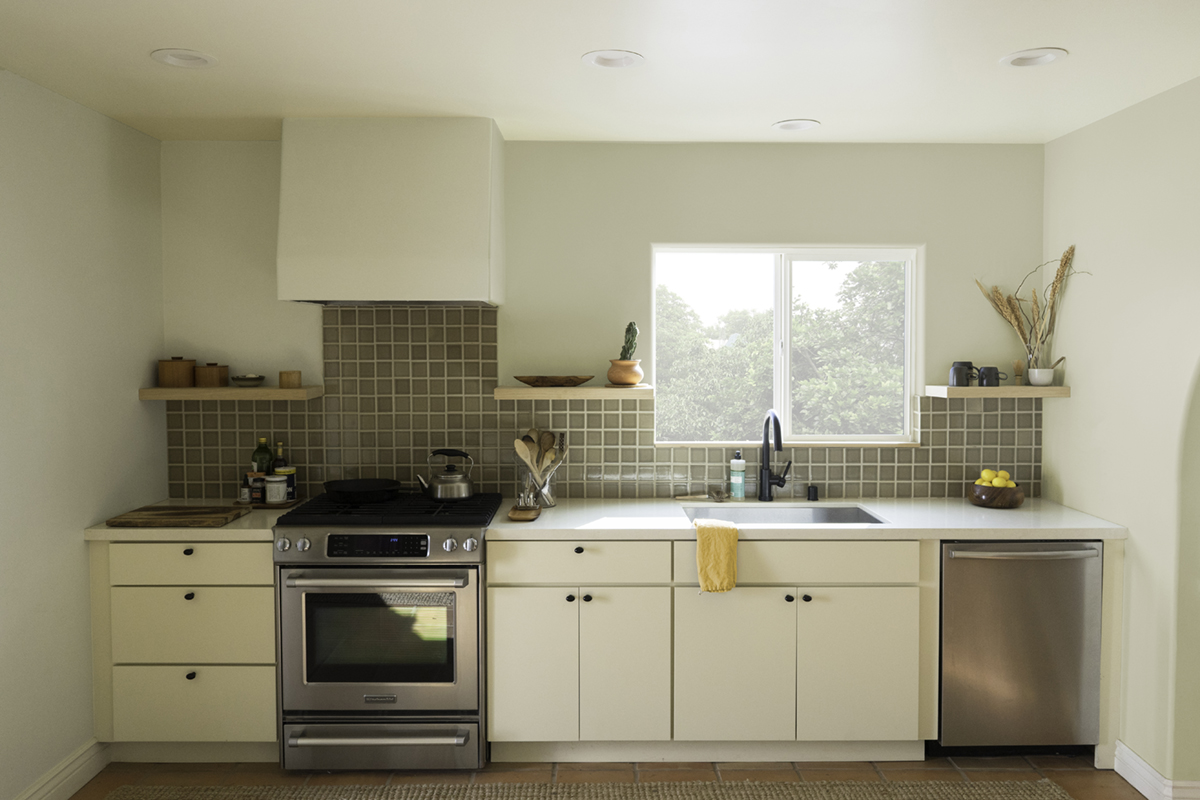


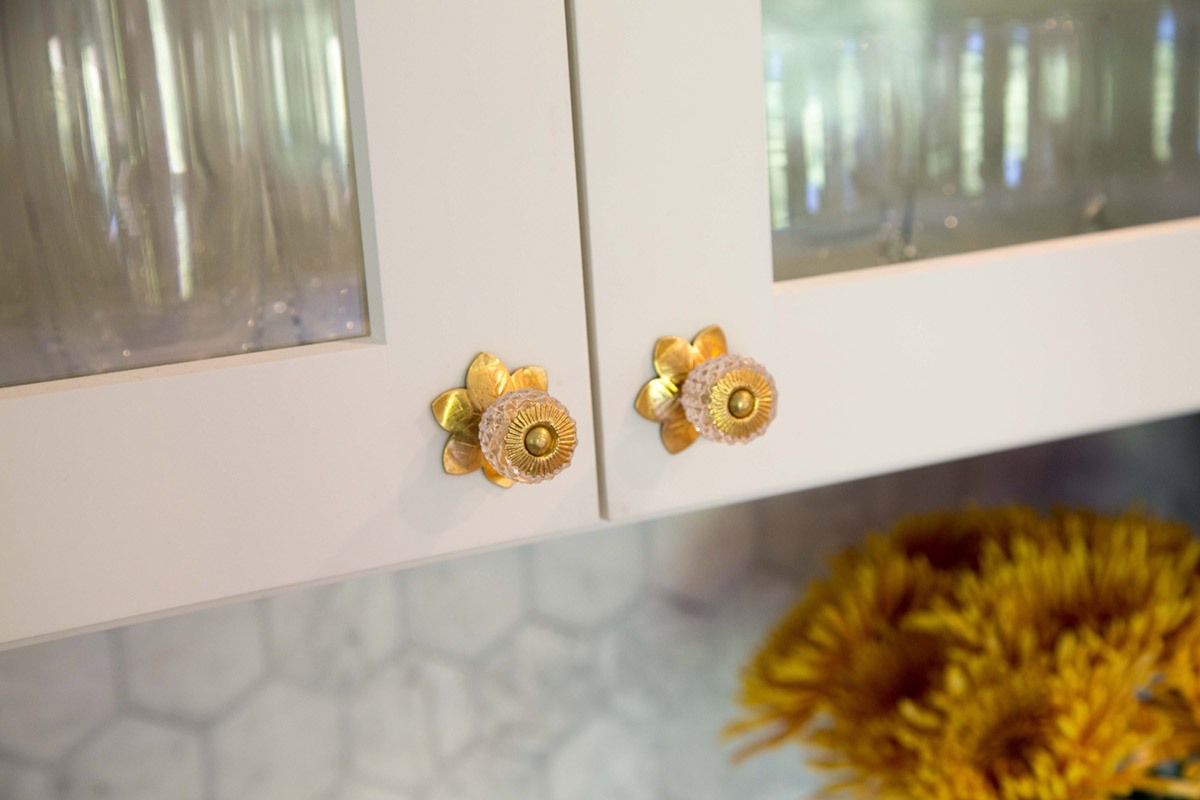
Bar pulls (also known as European pulls) and wire pulls have similar functionality in varying forms. They are easy to grasp, even for people with dexterity issues, and work well in modern and contemporary kitchens. Wire pulls are screwed into the cabinet at its two ends. Bar pulls are screwed in by two feet-like projections.
On doors, these pulls are typically installed in an upright, vertical position. Place the bottom hardware hole 2 1/2” to 3” from the bottom of the door front. Then center it horizontally on the door frame. Using the horizontal rail of the door frame, place your screw hole or orient the bottom end of the handle.
On cabinet drawers, these drawer pulls lay in a flat, horizontal position. Off-center the handles for more of a contemporary feel for 3-drawer base cabinets. This makes for a graceful and proportioned look. For pull-out storage such as this wastebasket cabinet, drawer pulls are often placed horizontally. They are commonly centered on the top rail of the door frame. If the pull-out is especially narrow, e.g. a 3″ pull-out spice rack, you can also choose to position handles vertically.
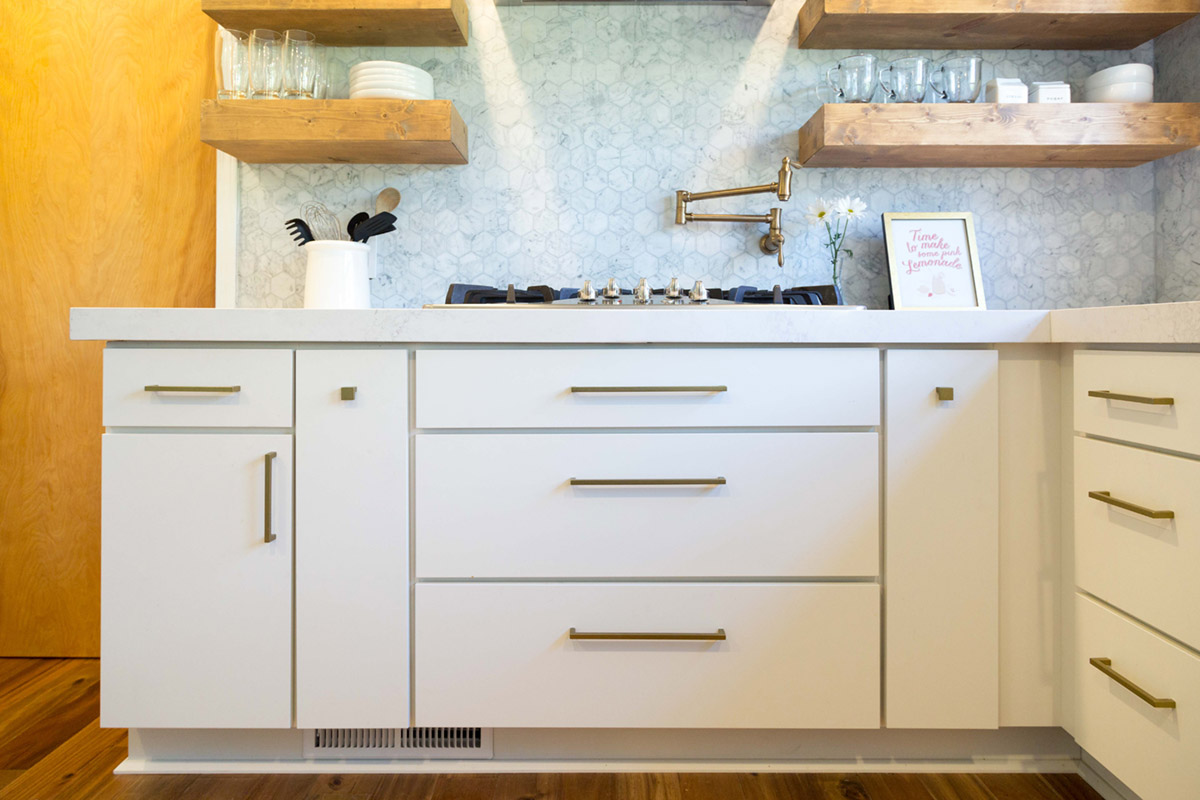
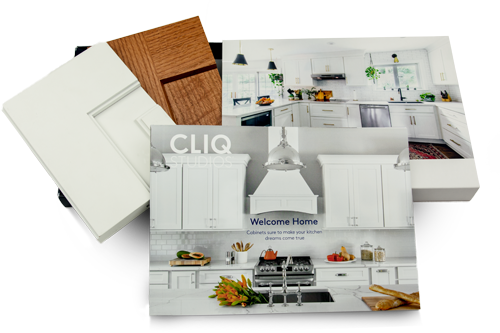
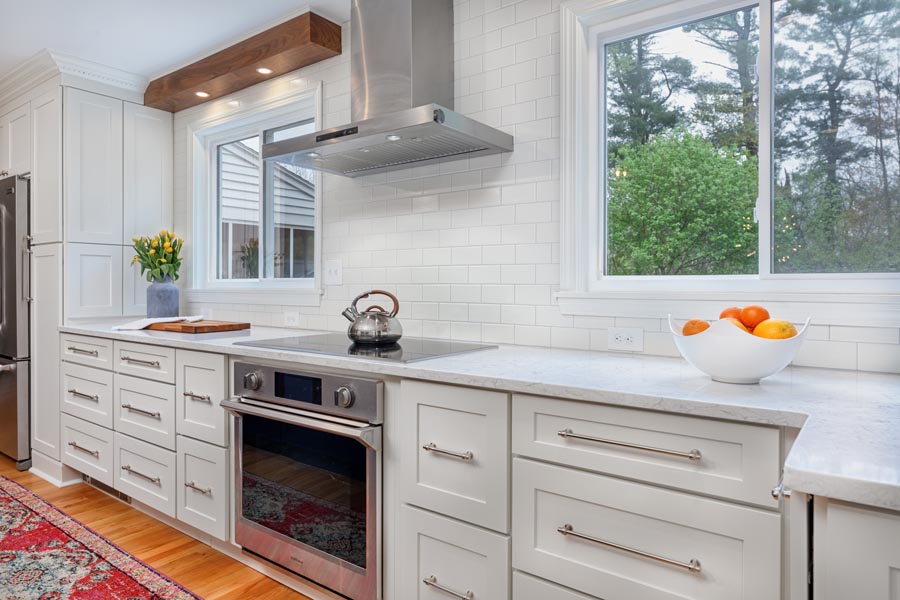
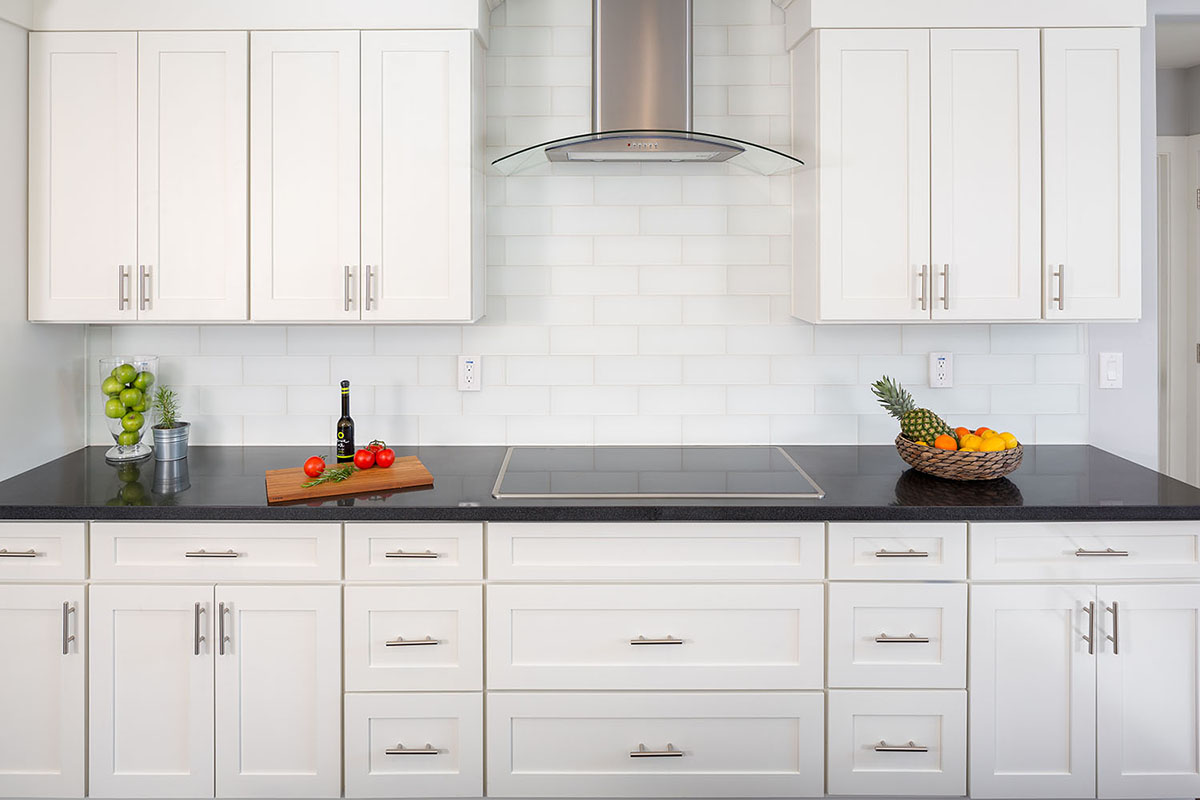
Cup pulls (also known as bin pulls) are upside-down cup shaped pulls popularized by Farmhouse and Victorian-era kitchens. Instead of gripping a protruding knob, you place your fingers underneath the ‘cup’.
Cup pulls have a wide appeal across many kitchen cabinet styles. They have a clean and timeless look that works with farmhouse, vintage, traditional, and transitional styles.

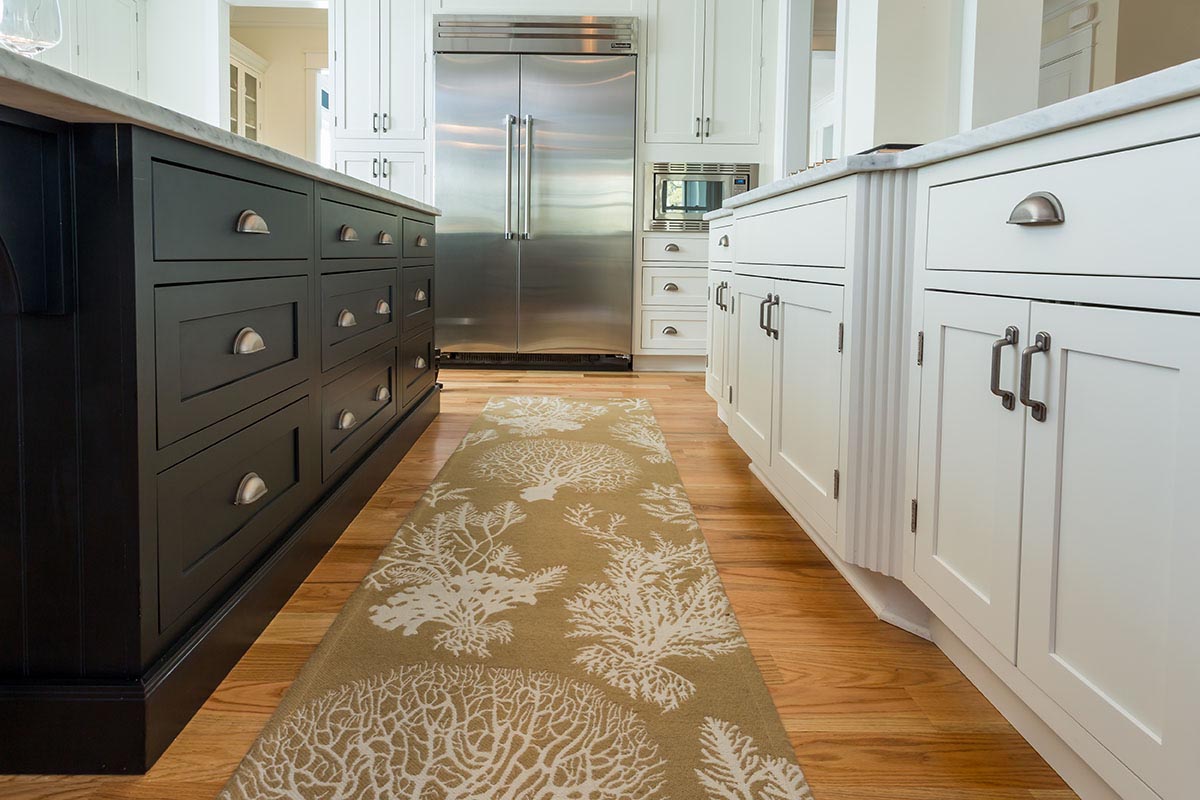


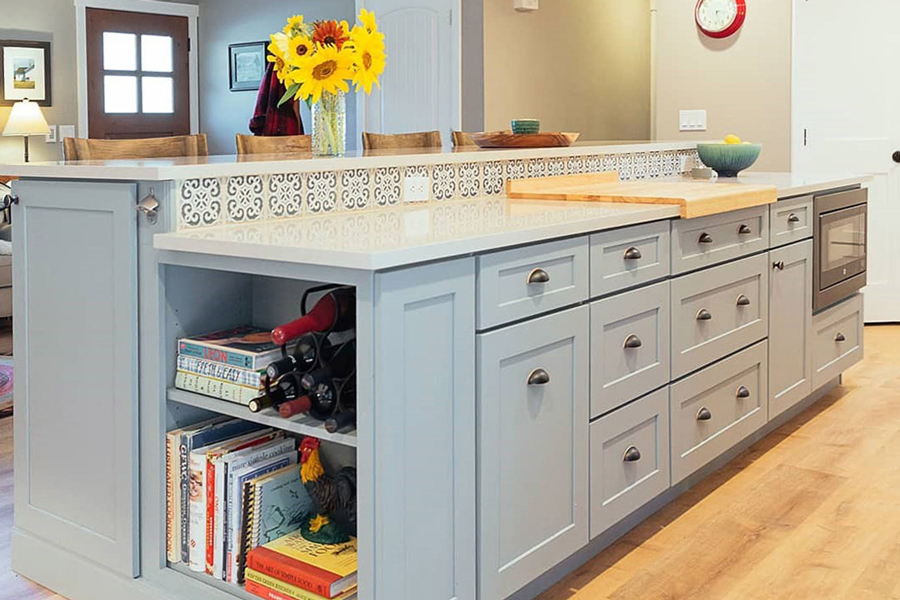
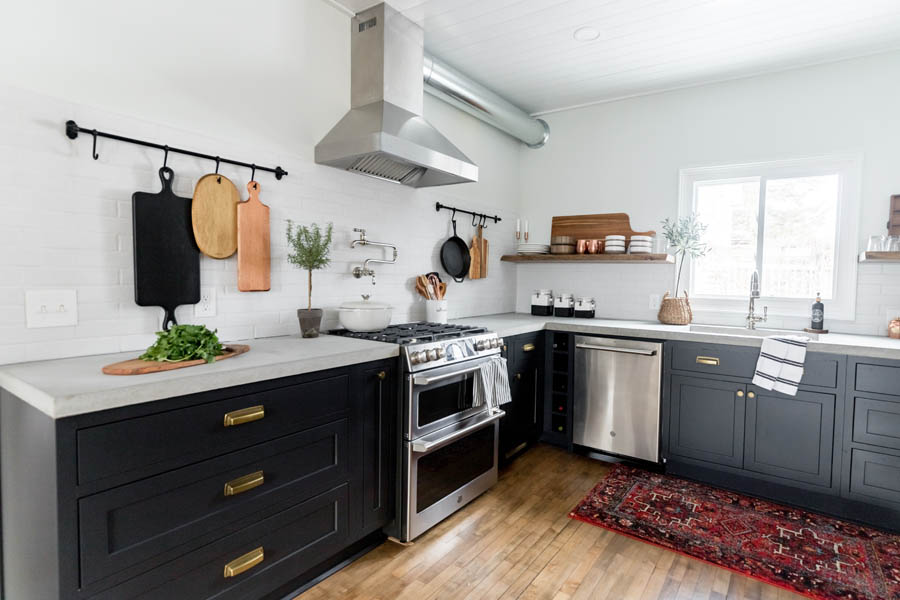
Edge pulls (also known as tab pulls or finger pulls) are a more contemporary style. They have a minimalist look that pairs excellently with slab-door cabinet styles. These pulls go on the top and bottom edges of your doors or drawers.
Place edge pulls in the opposite corner of the hinge on cabinet doors. It is often best to center finger pulls on top of your drawers.
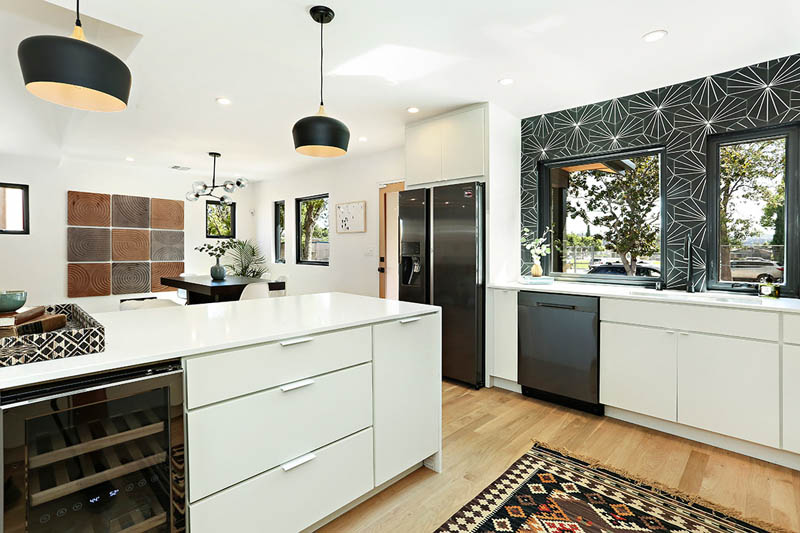


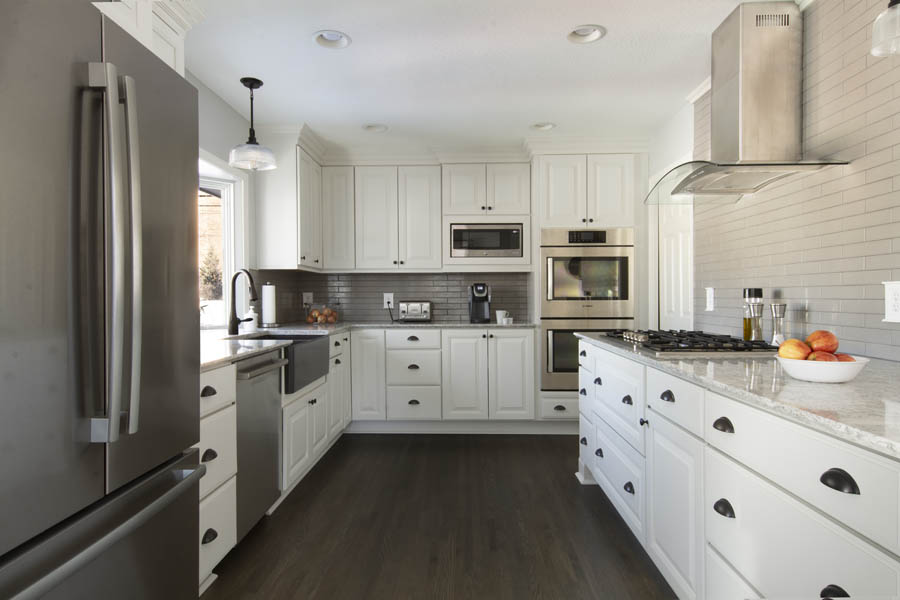
Take our quiz to get personalized cabinet style recommendations for your next project!
Get Started NowCabinet knobs and pulls are like jewelry for the kitchen. The right kitchen cabinet hardware can complement and accentuate the lines, colors, and textures of your space. The placement and positioning of cabinet hardware also makes your kitchen more functional, but is there a correct placement for cabinet handles? The answer is, no. You have a lot of flexibility with hardware placement to be as creative as you like.
While cabinet hardware placement does affect the functionality of the space, it’s a matter of personal taste and long-term goals. Does your home need to support aging in place, or will you only be there a few years? Let's look at different styles of kitchen cabinet knobs and pulls, and different hardware placements to find what’s best for you.
Do you know where to place your cabinet hardware or how to mix different styles? There are many options to choose from based on style and function. Whether you want a contemporary or a furniture-style design, there’s something for everyone. Explore what each of these 6 options has to offer along with our recommended cabinet hardware placement below.
For a classic kitchen look, use knobs on all doors and drawers. This type of cabinet hardware is simple and clean, keeping the focus on your beautiful new cabinets. As you can see in the graphic above, we recommend cabinet knob placement near where the rails and stiles of this door intersect. Typically, this measurement is around 2 – 3 inches above the bottom corner and centered on the vertical stile.
Drawer fronts are slightly different when it comes to hardware placement. On smaller drawer fronts, simply center the knob on either the center panel or the top rail for your desired look. For bigger drawer fronts, we recommend using two knobs to distribute the drawer's weight equally. Divide the drawer into thirds and drill each knob into the outer third as shown in the graphic above.
Like using all knobs, pulls offer similar simplicity. Using pulls will give your kitchen design a more contemporary look while making the cabinet hardware more prominent. Place your cabinet hardware on doors by lining up the bottom of your pulls where the rails and stiles meet again.
Just like knobs, mark your location around 2 – 3 inches from the bottom of the door and center your hardware. For example, let’s say you purchased 6-inch on center pulls. After you have found and marked your bottom drill location, measure 6 inches above and mark your final drill location.
Combine knobs and pulls for a furniture-style look. Using pulls on all doors and knobs on drawers will add interest to your kitchen while giving it a designer aesthetic. The same rule applies here for placement of each hardware type. For doors, locate and mark the center point of the stile where it meets the rail.
Based on your hardware size, measure and mark that same number of inches above your original drilling point. For drawers, anything under 24 inches should have one knob and anything over 24 inches should have two. Again, divide the drawer into thirds and drill each knob into the outer third as shown in the graphic above.
In this example, we are using knobs on wall cabinets and pulls on base cabinets. This hardware layout is about function and simplicity. Knobs on top gives you a streamlined look while pulls on the base cabinets provide extra leverage when pulling out heavy drawers with pots, pans and other kitchen necessities. Center your cabinet knobs on the vertical stile where it meets the bottom rail and drill holes for installation.
For cabinet pulls, measure their length and center those points on either the center drawer panel or the top rail and drill. To locate your drill holes for base cabinet doors, find the point where the stile and rail meet, and mark the center point like the graphic above. Measure downwards the length of your hardware and mark the second screw hole location.
Finger pulls are a beautiful, low-profile option for ultra-contemporary or Mid-century modern kitchen designs. This style of hardware is minimal which keeps the focus on other key design details like cabinets and other beautiful woodwork. For cabinet hardware placement, always locate the corner opposite of the cabinet hinges. Most finger pulls are drilled into the back of the cabinet door so only the front edge should show on the outside.
Depending on your comfort level, place finger pulls next to each other on adjoining doors making sure not to go past the edge of the door. If you would like some space between, push each finger pull ¼-inch front the edge of the door. Use a pencil to mark where the holes are on the back of each door and drill your holes.
Cabinet latches are a stunning piece of hardware that can add vintage beauty to your home. This type of cabinet hardware is not the most common, but it’s full of character and style. It also keeps your cabinet doors securely closed. Cabinet latches are a more specialized type of hardware so they should come with a template.
This type of hardware drills into the front of two adjoining cabinet doors and typically has two screw holes on each side. Use your template or line it up where the stile and rails meet like the photo above. Check that the hardware is level. Finally, mark the screw hole openings with a pencil and make sure the latch can open and close, then drill the holes.

Finding the perfect hardware is the key to a beautiful and functional kitchen. Explore stunning hardware in popular styles and finishes to complete your design now!
Shop Richelieu HardwareA kitchen cabinet knob is your most basic handle and great for doors and drawers alike. Knobs use a single screw and are traditionally round or circular. However, you can find them in new trendy shapes like square and T-shape. When it comes to materials and finishes, there are choices ranging from wood to ceramic, metal and crystal.
On drawers and pull-out cabinets, drawer pulls and knobs are typically centered on the drawer front. If you prefer, you can set your knobs on the upper part of the drawer front, as shown above. A knob in this position can provide additional leverage when opening a sink tilt-out tray. When installing knobs for pull-out cabinets such as a waste basket, make sure you choose a size that can accommodate and disperse the weight of the pull-out accessory.
Cup pulls (also known as bin pulls) are upside-down cup shaped pulls popularized by Farmhouse and Victorian-era kitchens. Instead of gripping a protruding knob, you place your fingers underneath the ‘cup’.
Cup pulls have a wide appeal across many kitchen cabinet styles. They have a clean and timeless look that works with farmhouse, vintage, traditional, and transitional styles.
Finger pulls (also known as tab pulls or edge pulls) are a more contemporary style. They have a minimalist look that pairs perfectly with slab-door cabinet styles. These pulls go on the top and bottom edges of your doors or drawers.
If you prefer an ultra-contemporary or Mid-century modern look making cabinetry the focal point, use finger pulls. Although they do still show, compared to other hardware styles, finger pulls keep the focus on the cabinets and other patterned details of the kitchen.
Cabinet latches are a beautiful hardware option that’s been around since the late 1800’s. This stylish option allows you to add vintage character to new kitchens. Latches are created from two adjoining pieces of hardware and installed on double-doors.
The hook side of the hardware latches to the other side with a quick turn of the handle creating a furniture-style look. Latches are typically found near the same location as a knob- 2 to 3 inches above the bottom cabinet stile. This hardware style is commonly used with shaker or decorative door styles.
Within the design industry, there is a 1:3 rule with cabinet hardware. The reason this rule was created is to provide guidance for picking hardware that’s proportional to your cabinet door and drawer size. For example, if your wall cabinet is 42 inches tall, divide that number by 3 and that is the size hardware you should choose (14”).
Sometimes there are valid reasons for not using this rule. Using hardware 1/3 the size of your doors does impact the design style making it look more contemporary. And, depending on the hardware brand you chose, larger hardware might be much more expensive.
Overall, this guideline is here as a general rule. That doesn’t mean it can’t be broken. At the end of the day, the goal is to be happy with your own kitchen or bath remodel. If you like smaller hardware or prefer to use two pieces for a drawer instead of one large handle, the choice is yours.
We do, however, recommend larger, more substantial kitchen cabinet door handles for pull-out accessories, heavy drawers and tall pantry doors to manage the weight. Using larger pieces or at least two knobs for big drawers and accessories will take some of the load off your cabinets during everyday use. It might even prolong the life of the cabinet, drawer glides and hardware overall.
Explore CliqStudios’ designer tips for choosing your hardware now!
Does your kitchen design include panel-ready appliances? It’s important to be informed about your hardware options. There is hardware designed specifically for panel-ready appliances and it is different than cabinet hardware. Usually it includes longer lengths, heavy-duty bolts and higher quality materials.
If your kitchen includes a custom appliance, read your appliance specifications packet first. The specs will typically tell you what hardware to buy that matches your appliances’ needs. Most appliance hardware needs to be installed prior to the panel’s installation. Once installation is complete, the larger scale of appliance hardware will allow you to effortlessly open refrigerators, freezers and dishwashers alike.
The most popular hardware styles of today are modern. This typically includes a combination of cabinet pulls, bin pulls and knobs with occasional latch cabinet hardware. Within these styles, many homeowners and designers alike are going for timeless finishes like brass, matte black, copper, oil-rubbed bronze and polished nickel.
Timeless modern designs are created using neutral colors that can be found in nature. If you love the idea of a design that lasts for decades, focus on searching for earthy colors and modern styles for longevity. In the long run, your kitchen will still look up to date and trendy.
Shop Richelieu hardware to order a sample today!
When it comes to finding the perfect hardware, your choice will be impacted by the overall cabinet door style and aesthetic chosen for the room. To paint a picture, if you were using a contemporary high-gloss slab door style in your kitchen, you wouldn’t use traditional bin pulls and knobs to complete the project.
The same goes for any other cabinet door style and aesthetic. Modern farmhouse kitchens for instance, typically use shaker cabinets with modern or transitional knobs, pulls and cup pulls. These could include some minor details and curved features, but overall, you will want something that matches the door style.
If there is a lack of cohesiveness between the hardware and door style, it could create a glaring mismatch in style. For those of you who don’t feel confident in your choices, it’s best to look for inspiration. Houzz, Pinterest and our gallery are all great resources where you can see what other homeowners have done.
For personalized assistance, talk to a CliqStudios designer today!

Explore our wide selection of decorative hardware in every size, finish and style.
Shop RichelieuWhen it comes to selecting cabinet hardware, there are a few key things to keep in mind: your style as well as the existing appliances and finishes throughout the space. Your style will play a significant role in choosing finishes. For example, if you are drawn to the industrial look, then mixing metals will help you achieve this look. If you have appliances already installed in the space and plan to keep them, then keep them in mind when choosing cabinet knobs. For instance, if you have black appliances, cabinet hardware in the same shade will pair nicely. Your CliqStudios designer can help you make the best selection for your space.
Cabinet knobs are typically installed directly halfway up the stile or framed portion of the cabinet face. This is usually 2 or 3 inches from any corner of the cabinet. For more information on installing cabinet knobs contact your CliqStudios designer.
There are numerous styles of both cabinet knobs and pulls that are becoming increasingly popular. Specifically, brass pulls, brushed nickel knobs, matte black knobs and pulls, as well as glass pulls, are being incorporated into more designs. For information on choosing the best cabinet hardware for your design, read this article put together by our experts!
On average, cabinet knobs range from 1 ¼ inch to 1 3/8 inch. This size is typical for standard-sized kitchen cabinets. If you have larger kitchen cabinets, oversized cabinet hardware can be used within the design. A CliqStudios designer can work one-on-one with you to select the perfect size and style of cabinet knobs for your cabinets.
Cabinet knobs are installed on the opposite side of the door hinges. The placement will vary depending on whether you are installing the hardware on wall cabinets or base cabinets. On wall cabinets, knobs are installed 2 ½ to 3 inches from the bottom corner of the cabinet door. On the other hand, knobs are installed 2 ½ to 3 inches from the upper corner of the cabinet door on base cabinets. If you have larger cabinets, like a pantry, then you may want to install larger coordinating knobs or pulls. For assistance selecting knobs and installing them, talk to your CliqStudios designer.
Most cabinet knobs out in the marketplace are going to be in-style based on demand, but there are a few most popular. Round, T-shape, and circular cabinet knobs are common favorites and come in a wide range of finishes. Some of the trending finishes include warmer and bolder tones like gold, brass, black, and oil rubbed bronze with some acrylic and crystal materials.
Kitchen cabinet knobs and pulls are both great choices for your cabinet hardware, but in order to find out which is better, it’s important to identify your personal needs. Cabinet knobs are simple and clean, however, it’s popular to have a mixture of both for a more designer look. Pulls are a great option if you enjoy a more decorative look and for age-in-place kitchens.
There is no hard and fast rule about how to determine the correct cabinet knob size. However, if the cabinet door or drawer is larger than 24” wide, consider choosing a larger size or adding a second cabinet knob to disperse the weight of the door or drawer.